Cats, enigmatic and mysterious, have fascinated humanity for thousands of years. Their behaviors are a complex mix of instinct, environment, and personality. The aloofness of cats is a notable characteristic, attributed to their nature as solitary hunters and their tendency towards independence. However, contrary to popular belief, cats do display social behaviors and communicate through vocalizations, body language, and scent marking. Understanding the nuances of cat behavior adds to the fascination of these captivating creatures.
Feline behavior is a topic of intrigue for cat lovers and researchers alike. What makes cats so aloof? Are they truly as mysterious as they seem? In this article, we delve into the fascinating world of cat behavior, exploring the evolutionary factors behind their aloofness, the intricate ways in which they communicate, their predatory instincts, and much more. Join me as we unravel the mystery of feline behavior and gain a deeper understanding of these enigmatic creatures.
Key Takeaways:
- Cats’ aloofness is attributed to their nature as solitary hunters and their tendency towards independence.
- Cats communicate through vocalizations, body language, and scent marking.
- Understanding cat behavior enhances our appreciation for their complexity.
- Domestic cats’ hunting behavior is a reflection of their ancestral lineage.
- Cats are crepuscular creatures, most active during dawn and dusk.
The Evolutionary Factors behind Cat Aloofness
When it comes to understanding cat behavior, it is essential to delve into the evolutionary factors that contribute to their aloofness. Cats, unlike their domesticated counterparts dogs, have a shorter history of domestication. This shorter domestication period allowed cats to retain their independent nature, which can be traced back to their ancestral days as solitary hunters in the wild. As solitary hunters, cats relied on themselves for survival, with minimal social interactions. This instinctual independence continues to influence their behavior and contributes to their perceived aloofness.
The evolutionary traits of cats as solitary hunters have shaped their behavior in unique ways. Cats have retained their instinctual need for self-sufficiency, which can sometimes manifest as aloofness. They have a strong sense of independence and prefer to rely on themselves, rather than seeking constant companionship. Although cats may not display the same level of outward affection as dogs, they still form strong bonds with their human companions. It is important to respect their independent nature while also providing them with the love, care, and attention they need.
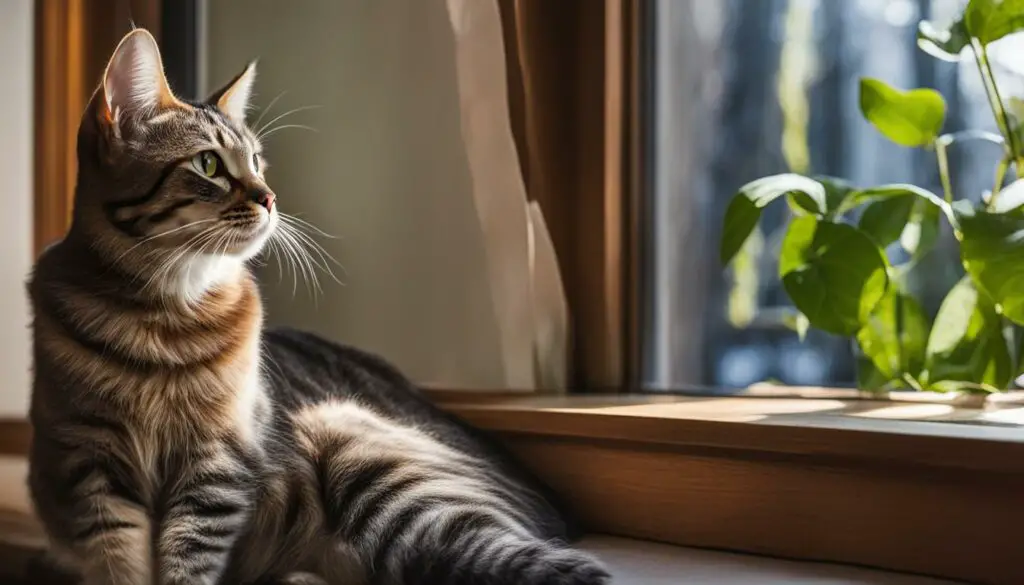
Understanding the evolutionary factors behind cat aloofness helps us appreciate their behavior and adapt our interaction with them accordingly. While cats may be viewed as aloof, it is crucial to recognize that their behavior is deeply rooted in their instincts and evolutionary history as solitary hunters. By respecting their need for independence and providing them with a nurturing environment, we can foster a strong bond with our feline companions.
The Enigmatic World of Cat Communication
Communication plays a vital role in the intricate world of cat behavior. Understanding how cats communicate is crucial in deciphering their emotions, needs, and intentions. Cats utilize a variety of communication methods, including vocalizations, body language, and scent marking.
Vocalizations
Cats have a wide range of vocalizations, each with its own unique meaning. The most common vocalization is meowing, which cats use to communicate with humans. They may meow to request food, attention, or express discomfort. Purring is another vocalization commonly associated with contentment, but it can also indicate stress or pain. Other vocalizations such as hissing, growling, and yowling are used in defensive or aggressive situations.
Body Language
Cats communicate a wealth of information through their body language. The position of their ears, tail, and body can convey their emotional state and intentions. For example, a cat with relaxed ears and a gently swaying tail may be feeling content, while an agitated cat will have flattened ears and a puffed-up tail. Additionally, eye contact and facial expressions are important components of feline communication. Direct eye contact can be interpreted as a sign of aggression, while slow blinks are a friendly gesture.
Scent Marking
Scent marking is another essential form of communication for cats. They use scent glands located on their face, paws, and tail to leave their unique scent on objects and surfaces. This behavior allows them to mark their territory and communicate with other cats. Cats also use urine marking to establish their presence and communicate with other animals. Scratching objects leaves visual and scent markings, acting as a visual signpost and serving as a way for cats to stretch their bodies.
Understanding cat communication enables us to better connect and respond to their needs. By paying attention to their vocalizations, body language, and scent marking, we can develop a deeper understanding of these enigmatic and captivating creatures.
An example of a beautiful table
| Communication Method | Description |
|---|---|
| Vocalizations | Meowing, purring, hissing, growling, yowling |
| Body Language | Ears, tail, and body position, facial expressions, eye contact |
| Scent Marking | Facial and paw scent marking, urine marking, scratching |
Predatory Instincts in Domestic Cats
Domestic cats, despite being well-fed pets, display a paradoxical behavior of hunting. This behavior is rooted in their evolutionary history as predators. Cats are natural hunters with strong instincts to hunt and capture prey. Even though they may not rely on hunting for survival, these predatory instincts remain ingrained in their DNA. The hunting behavior exhibited by domestic cats is a reflection of their ancestral lineage and their ability to adapt to their environment.
Understanding the predatory instincts of domestic cats is essential for providing them with a fulfilling and enriching environment. Engaging in hunting-like activities, such as interactive play sessions with toys that simulate prey, can help satisfy their natural instincts. These activities provide mental stimulation, physical exercise, and a sense of accomplishment for cats. It is important to provide appropriate outlets for their predatory behavior to prevent boredom and promote their overall well-being.
Additionally, the predatory instincts of domestic cats can sometimes manifest in unwanted behaviors, such as hunting wildlife or small pets. It is crucial for cat owners to manage their cat’s environment responsibly to prevent any harm to themselves or other animals. This can include keeping cats indoors or providing them with a secure outdoor enclosure that allows them to enjoy the benefits of the outdoors while minimizing the impact on local wildlife.
Table: Comparison of Domestic Cats and Wild Felids
| Domestic Cats | Wild Felids | |
|---|---|---|
| Social Structure | Solitary or small social groups | Varies (solitary or social) |
| Hunting Behavior | Hunt primarily for play and instinct | Hunt for survival and sustenance |
| Prey Preference | Small mammals and birds | Varies (depends on species) |
| Range | Limited to home territory | Large territories for survival |
While domestic cats exhibit similar predatory instincts to their wild counterparts, there are notable differences in their hunting behavior and social structure. Domestic cats have adapted to a lifestyle with humans, which has influenced their behavior and needs. Understanding and accommodating these instincts in a responsible manner is crucial for providing domestic cats with a happy and fulfilling life.
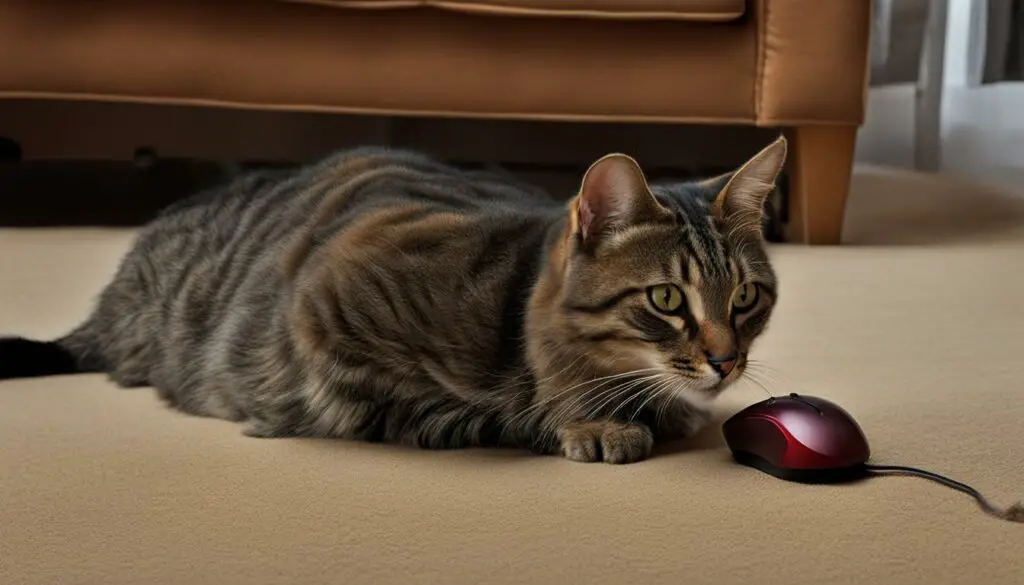
The Sleeping Patterns of Cats
Understanding the sleeping patterns of cats is key to unraveling the mysteries of feline behavior. Cats are crepuscular creatures, meaning they are most active during the dawn and dusk hours. This behavior is deeply rooted in their ancestral instincts as hunters, enabling them to take advantage of low-light conditions to stalk and capture prey. Despite domestication, many cats still adhere to these nocturnal rhythms, opting to nap during the day and becoming more active during the early morning and evening hours.
Just as cats have adapted their sleeping patterns to fit into our human-centric lifestyles, it is important for cat owners to respect their natural tendencies. Providing a calm and comfortable environment conducive to sleep can help ensure that cats get the rest they need. This includes creating designated resting areas with soft bedding, minimizing noise and distractions, and maintaining a consistent routine to establish a sense of security and predictability.
While cats may enjoy the occasional daytime nap, it is essential to recognize that their sleep needs may differ from ours. On average, cats sleep for around 12 to 16 hours a day, conserving their energy for periods of activity. Cat owners should not be alarmed by their furry companions’ seemingly excessive sleep habits, as it is a normal part of their behavior. Understanding and accommodating their unique sleeping patterns will foster a harmonious and enriching environment for both cats and their human companions.
| Common Sleeping Behaviors | Description |
|---|---|
| Curling up in a ball | Cats often curl up in a tight ball, tucking their paws beneath their body to conserve warmth and feel secure. |
| Stretching out | When cats are feeling relaxed and safe, they may stretch out, fully extending their limbs while snoozing. |
| Choosing elevated spots | Cats have a natural inclination to sleep in high places, which provides them with a vantage point to observe their surroundings and feel secure. |
| Napping with one eye open | Cats have the unique ability to enter a state of light sleep, allowing them to remain alert to potential dangers while still catching some Zs. |
Remember, each cat is an individual, and their sleeping preferences may vary. By observing and respecting their natural behaviors, cat owners can ensure their feline companions have a peaceful and restorative sleep, promoting their overall well-being.
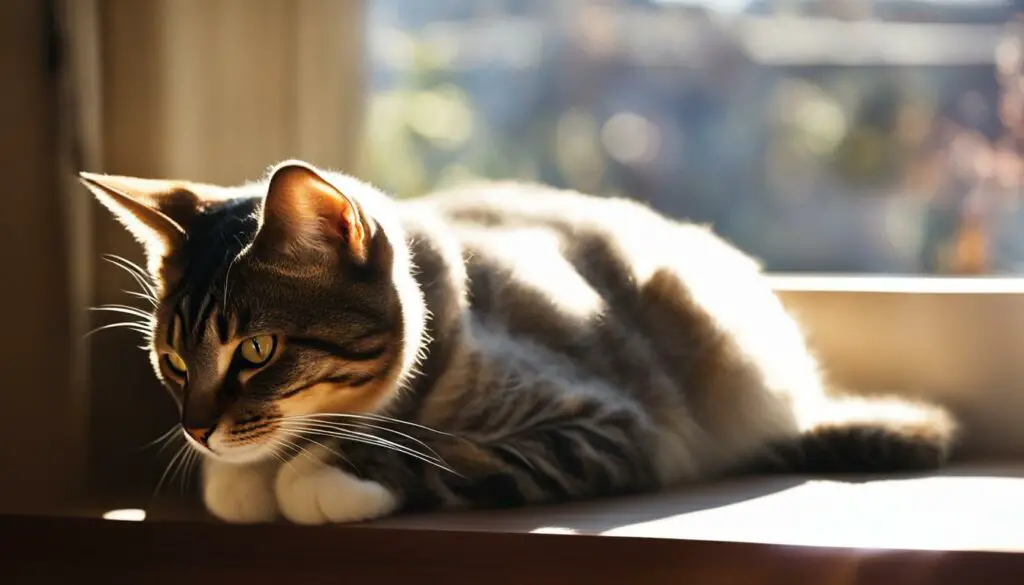
Nurturing Restful Sleep for Cats
Creating a serene sleeping environment for your cat can help promote restful sleep. Consider the following tips:
- Provide a comfortable bed or designated sleeping area that is cozy and inviting.
- Avoid excessive noise and disturbances during your cat’s sleeping hours.
- Ensure proper temperature control to keep your cat from becoming too hot or too cold.
- Establish a regular routine to help your cat feel secure and provide a sense of predictability.
- Offer mental and physical stimulation during awake hours to help expend energy and encourage deeper sleep.
By understanding and accommodating the sleeping patterns of cats, we can optimize their well-being and foster a stronger bond with our feline friends.
The Fascinating World of Cat Grooming
Cat grooming is an essential behavior that serves various purposes. Cats spend a significant amount of time grooming themselves, using their tongues to clean their fur. This behavior helps regulate their body temperature, promotes blood flow, and removes dirt and parasites from their coats. Grooming also serves as a self-soothing mechanism for cats, helping them relax and providing a sense of comfort. It is a vital part of their daily routine and contributes to their overall well-being.
While grooming, cats meticulously clean every inch of their bodies, ensuring that their fur remains clean and free from tangles. This attention to detail not only keeps them looking their best but also helps prevent skin irritations and infections. Additionally, grooming allows cats to distribute natural oils throughout their fur, keeping it smooth and shiny. It is remarkable to observe how cats contort their bodies and use their tongues to groom hard-to-reach places, demonstrating their flexibility and agility.
Cat grooming also has social benefits. In multi-cat households, grooming plays a role in strengthening social bonds between cats. It is not uncommon to see two cats grooming each other as a sign of affection and trust. It is a form of social interaction that helps cats maintain harmonious relationships with their feline companions. Grooming behaviors can also be seen between cats and their human companions, further deepening the bond between them.
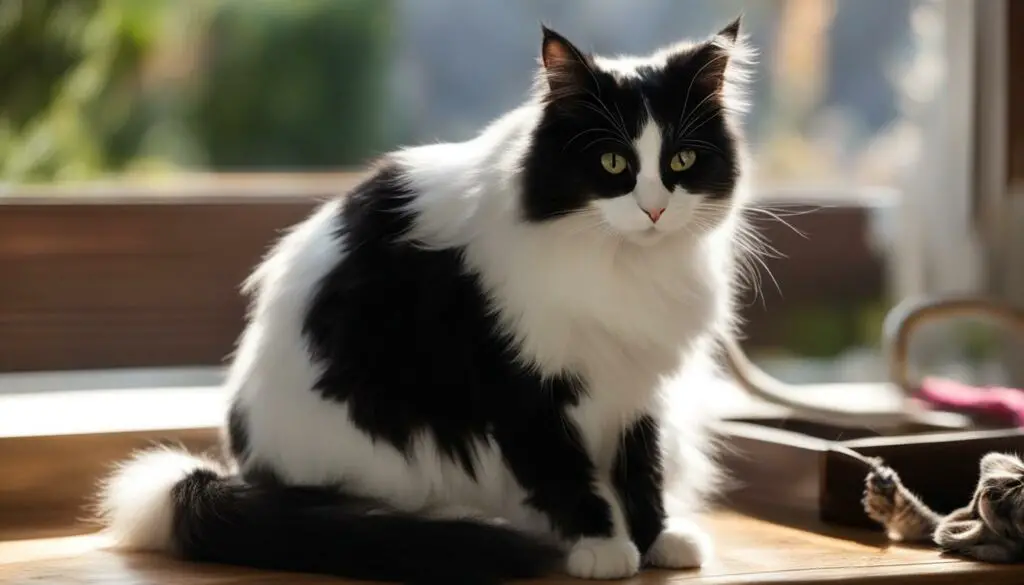
The Benefits of Cat Grooming
Grooming is not just about maintaining hygiene and social bonds; it also has physiological benefits for cats. The process of licking and grooming stimulates the release of endorphins, which are natural feel-good hormones. This self-soothing mechanism helps cats alleviate stress and anxiety, providing them with a sense of calm and contentment. Regular grooming sessions can help cats cope with environmental changes, such as moving to a new home or the addition of a new family member.
As cat owners, it is important to support and encourage healthy grooming habits in our feline companions. Providing them with appropriate grooming tools, such as brushes and combs, can help prevent matting and hairballs. Regular vet visits are also essential to address any underlying medical conditions that may affect a cat’s grooming behavior. By understanding and appreciating the significance of cat grooming, we can ensure that our beloved feline friends lead happy and fulfilling lives.
The Peculiar Fascination with Boxes
One of the endearing and often perplexing behaviors of cats is their peculiar fascination with boxes. It seems that no matter the size or shape, if there’s a box in the room, a cat will find its way into it. This behavior is rooted in their instinctual need for security and their preference for enclosed spaces. Boxes provide cats with a cozy and secure environment where they can observe their surroundings without feeling vulnerable.
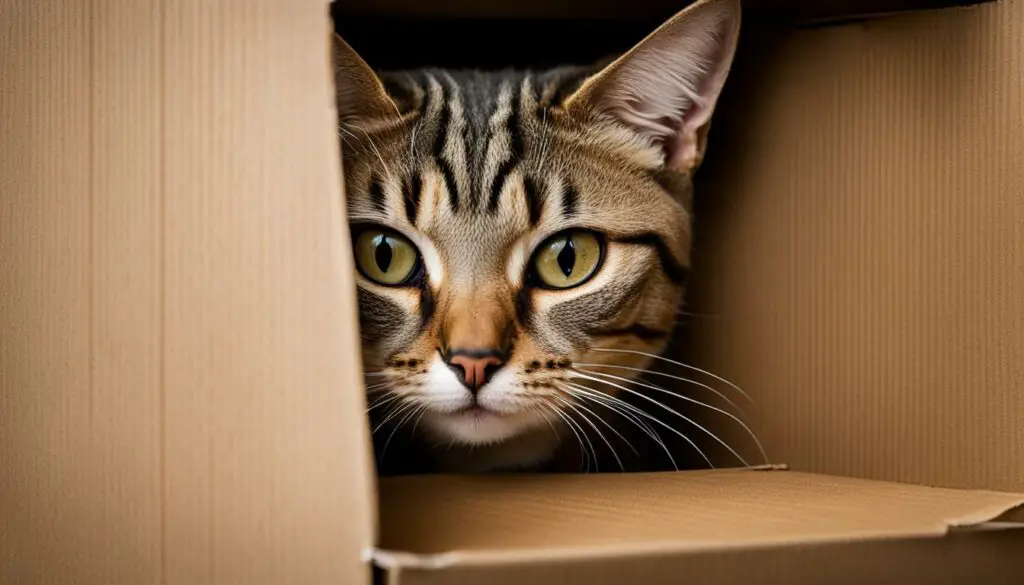
Aside from providing a sense of security, boxes also fulfill cats’ environmental needs. They offer warmth, a secluded space to rest, and a vantage point for monitoring their surroundings. Cats are natural predators, and even in a domestic setting, their hunting instincts drive them to seek out enclosed spaces where they can conceal themselves and patiently watch for potential prey. Boxes offer the perfect hiding spot that satisfies their complex behavioral and environmental needs.
To better understand why cats are so drawn to boxes, researchers have conducted studies to observe their behavior. One study published in the journal Applied Animal Behaviour Science found that when cats were given a choice between a plain box and a box with a circle or an X drawn on the floor, they overwhelmingly chose the box with the circle. This suggests that cats are attracted to enclosed spaces and seek out environments that provide a sense of security and comfort.
The Unique Bond between Cats and Humans
Cats, often regarded as aloof creatures, are capable of forming deep and meaningful connections with their human counterparts. While their expressions of affection may differ from dogs, the bond between a cat and its owner is built on mutual understanding, trust, and respect. By recognizing and appreciating the unique characteristics of cats, we can cultivate a strong and fulfilling relationship with these enigmatic creatures.
Establishing a strong bond with a cat requires understanding their individual personalities and preferences. Each cat has its own distinct ways of showing affection, whether it’s through gentle headbutts, slow blinks, or soft purring. By observing and interpreting their body language and vocalizations, we can better understand their needs and desires, building trust and deepening our connection.
To foster a strong bond with a cat, it’s crucial to create a stable and secure environment. Cats thrive on routine and consistency, so providing a consistent feeding schedule, comfortable sleeping spaces, and enriching toys and activities can help them feel safe and content. Respecting their boundaries and allowing them to approach and interact on their own terms further strengthens the bond of trust.
Quotes:
“I have found that when you are deeply troubled, there are things you get from the silent devoted companionship of a cat that you can get from no other source.” – Doris Lessing
“One small cat changes coming home to an empty house to coming home.” – Pam Brown
Table: Cat-Human Interaction Tips
| Tip | Description |
|---|---|
| Observe body language | Pay attention to your cat’s tail position, ear movement, and eye contact to gauge their mood and comfort level. |
| Respect personal space | Allow your cat to approach and initiate interaction. Avoid forcing physical contact if they seem hesitant or uncomfortable. |
| Positive reinforcement | Reward desired behaviors with treats, praise, or playtime to encourage a positive association and strengthen the bond. |
| Create a stimulating environment | Provide scratching posts, toys, and interactive games to keep your cat mentally and physically engaged. |
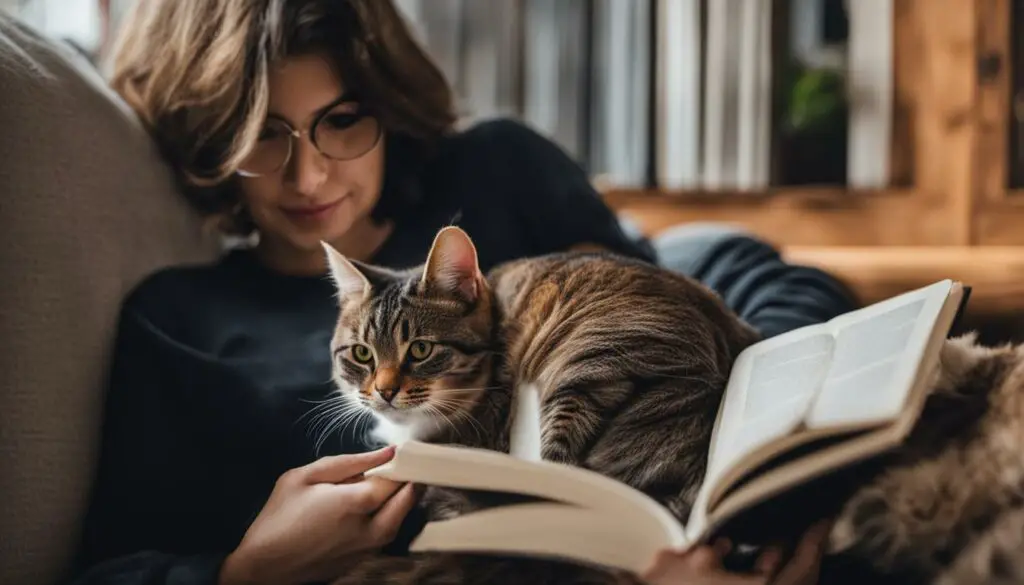
Building a strong bond with a cat is a delightful journey that requires patience, understanding, and a willingness to meet their individual needs. Through mutual respect and affection, we can form a unique connection with our feline friends that brings joy, companionship, and a shared understanding that transcends words.
The Intricate Dance of Instinct and Individuality
Understanding cat behavior goes beyond acknowledging their instinctual nature. While instinct plays a significant role in shaping their behavior, each cat also possesses its own unique personality traits. This intricate dance between instinct and individuality creates the fascinating array of behaviors that make cats such captivating creatures.
Cats’ instinctual behavior can be traced back to their evolutionary history as solitary hunters. Their independent nature and self-reliance, honed over thousands of years, contribute to their perceived aloofness. However, within this framework of instinct, each cat expresses its personality in distinct ways.
Factors such as genetics, early experiences, and environmental influences contribute to the development of a cat’s behavior. Just like humans, cats have their preferences, quirks, and idiosyncrasies that make them unique. Some cats may be more outgoing and sociable, while others may be shy and reserved. This individuality adds depth and richness to the tapestry of cat behavior.
The Influence of Genetics
Genetics plays a significant role in shaping cat behavior. Different cat breeds exhibit variations in temperament, sociability, and cognitive abilities, which are influenced by their genetic makeup. For example, the Bengal breed is known for its active and energetic nature, while the Ragdoll breed tends to be more relaxed and affectionate. However, it’s important to remember that genetics are not the sole determinants of behavior. Environmental factors and individual experiences also play crucial roles in shaping a cat’s behavior.
The Complexity of Cat Behavior
“Cats are like puzzle pieces, each one unique and fitting into the larger picture of feline behavior. Exploring the intricacies of instinct and individuality allows us to appreciate the complexity and richness of their behaviors.”
Understanding the interplay between instinct and individuality is key to fostering a deeper appreciation for the complexity of cat behavior. It helps us recognize that cats are not simply aloof creatures, but rather intricate beings with their own set of behaviors influenced by both nature and nurture. By embracing their individuality, we can create a nurturing environment that caters to their specific needs, forging a stronger bond with these enigmatic companions.
| Instinct | Individuality |
|---|---|
| Cats are solitary hunters by nature, leading to their independent behavior. | Each cat has its unique personality, influencing their behavior in distinct ways. |
| Wild instincts drive cats to exhibit predatory behaviors, even as domestic pets. | Early experiences and environmental factors shape a cat’s behavior and preferences. |
| Scent marking and territorialism are instinctual behaviors for establishing boundaries. | Genetics and breed traits can influence a cat’s temperament and sociability. |

Exploring the World of Feline Psychology
Feline psychology is a captivating field that delves into the intricate workings of a cat’s mind. By studying their behavior, emotions, and cognitive abilities, we gain valuable insights into their unique personalities and needs. Feline psychology encompasses various aspects, including social structure, communication, problem-solving, and emotional well-being.
One fascinating area of study is social structure within cat colonies. Cats have a complex hierarchy that influences their interactions and behaviors. Researchers investigate how cats establish social bonds, communicate within their groups, and navigate social dynamics.
Understanding feline psychology also sheds light on how cats problem-solve and adapt to their environment. Cats possess cognitive abilities that enable them to find solutions to challenges they encounter. Observing their problem-solving skills provides valuable insights into their intelligence and adaptability.
Furthermore, studying feline psychology allows us to gain a deeper understanding of cats’ emotional well-being. Cats experience a range of emotions, including joy, fear, and contentment. Recognizing their emotional states and providing a nurturing environment that meets their emotional needs is crucial for their overall happiness and mental health. Feline psychology helps us create enriching environments and establish strong bonds based on trust, respect, and mutual understanding.
The Importance of Socialization in Feline Psychology
Socialization plays a vital role in feline psychology, shaping a cat’s behavior and emotional well-being. Early experiences and interactions with humans, other animals, and the environment influence a cat’s social skills and ability to form positive relationships throughout their lives. Proper socialization helps cats develop confidence, decreases their tendency towards fearfulness or aggression, and fosters their ability to adapt to new situations.
During the socialization period, which typically occurs between 2 to 7 weeks of age, kittens learn to interact and communicate with their littermates, mother, and humans. Positive experiences during this critical period lay the foundation for healthy social behavior later on. Socialization should continue beyond the initial stages, with exposure to various people, animals, and environments. This ongoing socialization helps cats become more comfortable and adaptable, reducing the likelihood of behavioral issues in the future.
| Benefits of Socialization in Cats | Socialization Techniques |
|---|---|
| Increased confidence and decreased fearfulness | Gradual exposure to new people and situations |
| Improved ability to handle stress | Positive reinforcement training |
| Enhanced social skills and reduced aggression | Providing opportunities for supervised interaction with other animals |
| Ability to adapt to new environments | Creating a safe and stimulating environment |
“Proper socialization is essential for a cat’s emotional well-being and overall quality of life. It helps them develop the necessary social skills to navigate various situations and form positive relationships. By understanding the importance of socialization in feline psychology, we can provide the necessary support and opportunities for cats to thrive.”
In conclusion, exploring the realm of feline psychology offers a deeper understanding of cats’ behavior, emotions, and cognitive abilities. It allows us to provide optimal care, create enriching environments, and strengthen our bond with these remarkable creatures. By recognizing the importance of socialization and understanding their unique needs, we can ensure the well-being and happiness of our feline companions.
The Influence of Breed on Feline Behavior
When it comes to feline behavior, different cat breeds exhibit unique traits and characteristics that are influenced by genetics and selective breeding practices. Understanding breed-specific behavior can help cat owners tailor their care and environment to meet their cat’s specific needs, fostering a harmonious living environment.
One aspect that varies among cat breeds is temperament. Some breeds, such as the Maine Coon and Ragdoll, are known for their friendly and sociable nature, while others, like the Siamese and Bengal, may be more vocal and demanding of attention. Breed-specific traits also extend to cognitive abilities. Certain breeds, like the Abyssinian and Bengal, are highly intelligent and require mental stimulation to prevent boredom and destructive behavior.
While breed-specific tendencies can provide insights into a cat’s behavior, it’s important to remember that individual variations within breeds exist. Each cat has its own unique personality and preferences. Therefore, it’s crucial to take into account the individual needs and characteristics of your cat and provide a tailored approach to their care and environment.
| Breed | Temperament | Cognitive Abilities |
|---|---|---|
| Maine Coon | Friendly, sociable | Normal |
| Ragdoll | Gentle, affectionate | Normal |
| Siamese | Vocal, demanding | Normal |
| Abyssinian | Energetic, intelligent | High |
| Bengal | Active, curious | High |
Conclusion
The influence of breed on feline behavior highlights the importance of understanding the unique characteristics and needs of individual cats. While breed-specific tendencies can provide insights, it is essential to recognize that each cat is a unique individual with their own personality. By taking into account both breed-specific traits and individual variations, cat owners can provide optimal care and create a nurturing environment that supports their cat’s well-being.
Dispelling Misconceptions about Cats
There are many misconceptions when it comes to cats and their behavior. One common myth is that cats are aloof and uninterested in human affection. However, this couldn’t be further from the truth. Cats may not display affection in the same overt manner as dogs, but they show their love in their own unique ways.
“Cats are often misunderstood. Their independent nature and subtle ways of showing affection can be mistaken for aloofness. But if you pay attention to their cues, you’ll see that cats are actually quite affectionate,” says feline behavior expert Dr. Jane Peterson.
Cats form strong bonds with their human companions and seek out their company. They may choose to sit close by, purr softly, or give gentle head bumps as signs of affection. It’s important to understand and appreciate the complexity of feline behavior to recognize these gestures of love.
Another misconception is that cats are not social animals. While cats are independent by nature, they do exhibit social behaviors. They communicate through vocalizations, body language, and scent marking. Cats also form complex social hierarchies, particularly in multi-cat households or colonies. Understanding these social dynamics can help create a harmonious environment for our feline friends.
| Misconception | Reality |
|---|---|
| Cats are aloof and uninterested in human affection. | Cats show affection in unique ways and form strong bonds with their human companions. |
| Cats are not social animals. | Cats exhibit social behaviors and form complex social hierarchies. |
| Cats are low-maintenance pets. | Cats require physical and mental stimulation, social interaction, and regular veterinary care. |
| Cats always land on their feet. | Cats have a remarkable righting reflex but can still suffer injuries from falls. |
One popular misconception is that cats are low-maintenance pets. While they may be more independent than dogs, cats still require physical and mental stimulation, social interaction, and regular veterinary care. They benefit from playtime, interactive toys, and environmental enrichment to keep them happy and engaged.
Finally, the belief that cats always land on their feet is not entirely accurate. Cats do have a remarkable righting reflex that helps them orient themselves during falls, but they can still suffer injuries. It is essential to provide a safe and cat-friendly environment to minimize the risk of falls and accidents.
By debunking these myths and misconceptions, we can gain a better understanding of feline behavior and provide the love and care our cats truly deserve.
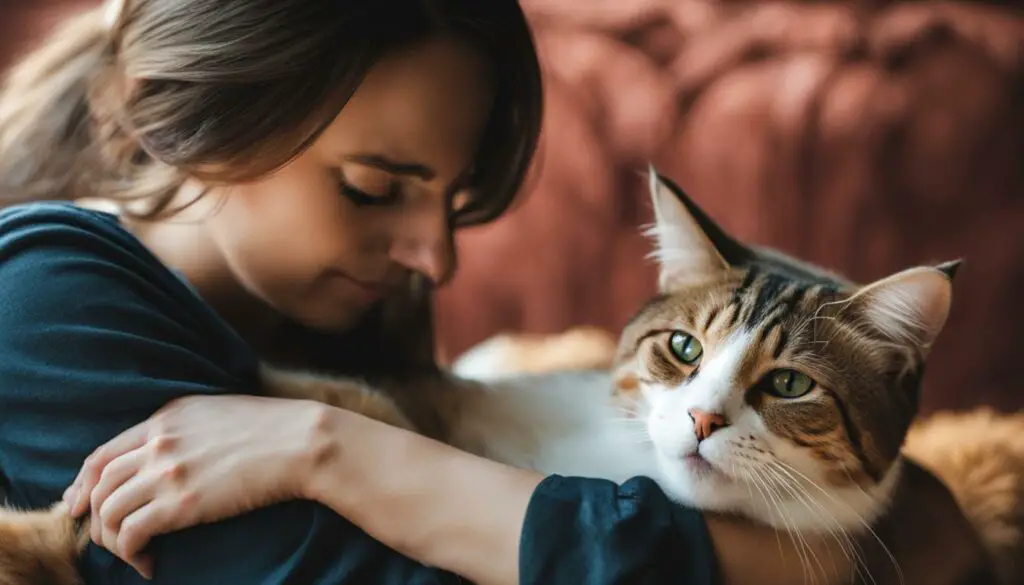
The Impact of Genetics on Cat Behavior
Genetics play a significant role in shaping a cat’s behavior, influencing their temperament, sociability, and cognitive abilities. Breed-specific traits are often evident in certain cat breeds, with each breed having its own unique characteristics. For example, the Maine Coon breed is known for its friendly and sociable nature, while the Siamese breed is known for its vocal and demanding personality. Understanding these breed-specific traits can help cat owners tailor their care to meet their cat’s specific needs.
However, it’s important to note that genetics are not the sole determinants of behavior. Individual personality, early experiences, and the environment also play crucial roles in shaping a cat’s behavior. Just like humans, cats have their own unique personalities and preferences. Some cats may be more independent and aloof, while others may be more affectionate and social. It’s essential to consider these individual differences when interacting with and caring for cats.
As responsible cat owners, we can create a stimulating and enriching environment that supports our cats’ genetic predispositions. Providing toys and activities that cater to their natural instincts, such as hunting and climbing, can help satisfy their innate needs. Additionally, offering plenty of socialization opportunities and positive reinforcement can contribute to their overall well-being. By understanding the impact of genetics on cat behavior and acknowledging the individuality of each cat, we can provide the best possible care for our feline companions.
| Breed | Temperament | Sociability | Cognitive Abilities |
|---|---|---|---|
| Maine Coon | Friendly, sociable | Highly sociable | Intelligent |
| Siamese | Vocal, demanding | Highly social | Intelligent |
| Persian | Calm, gentle | Reserved | Normal intelligence |
| Sphynx | Curious, energetic | Highly sociable | Intelligent |
The Importance of Emotional Well-being in Cats
Cats are not just aloof creatures; they also possess deep emotions that contribute to their overall well-being. Understanding and nurturing their emotional needs is crucial for providing a fulfilling life for our feline companions. By creating an environment that promotes emotional well-being, we can enhance their happiness and strengthen our bond with them.
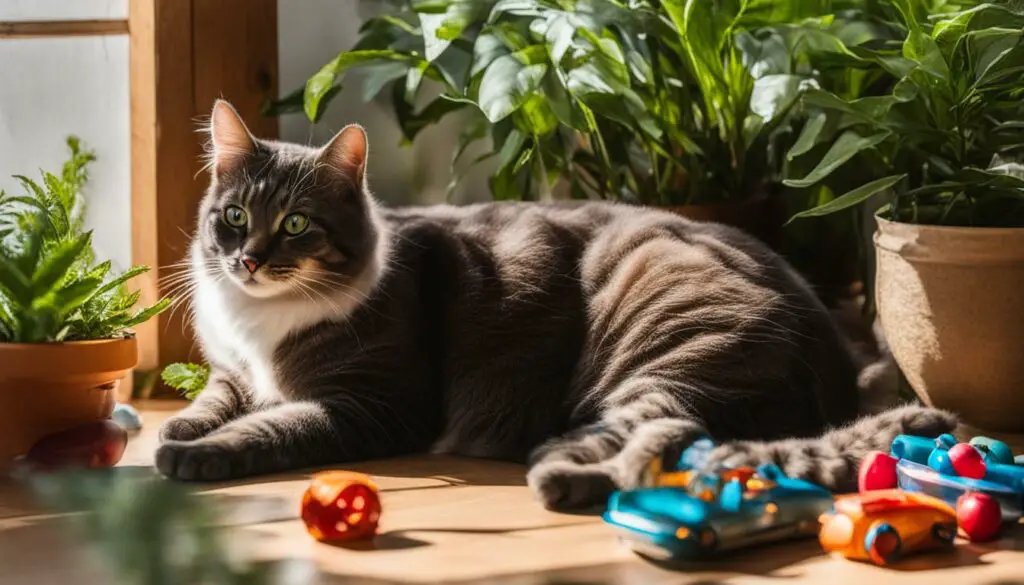
The Significance of Cat Emotions
Like humans, cats experience a range of emotions, including happiness, contentment, fear, stress, and anxiety. Recognizing and addressing their emotional state is essential for maintaining their overall health and happiness. Stressors such as changes in routine, new environments, or conflicts with other pets can have a significant impact on a cat’s emotional well-being.
Environmental Enrichment for Emotional Stability
Cats thrive in environments that provide mental and physical stimulation. Environmental enrichment is the practice of creating a stimulating environment that meets a cat’s natural instincts and needs. This includes providing interactive toys, scratching posts, hiding spots, and vertical spaces for climbing. Enrichment activities help alleviate boredom, reduce stress, and promote a sense of security and well-being in cats.
Nurturing a Bond Through Emotional Care
Building a strong bond with a cat involves nurturing them emotionally. This includes providing a safe and secure environment, consistent routines, and positive reinforcement. Taking the time to understand and respond to their individual preferences and needs fosters a sense of trust and deepens the emotional connection between cats and their human companions.
In conclusion, caring for a cat’s emotional well-being is vital for their happiness and overall quality of life. By recognizing their emotions, providing environmental enrichment, and nurturing a strong emotional bond, we can create a harmonious and fulfilling relationship with our feline friends.
Effective Cat-Human Interaction Strategies
When it comes to interacting with cats, understanding their unique behaviors and communication signals is essential. By observing and interpreting their body language, vocalizations, and preferences, we can establish a meaningful connection with our feline friends. Here are some strategies for effective cat-human interaction:
1. Respect their boundaries:
Cats are independent creatures that value their personal space. It’s important to respect their boundaries and not force interaction when they show signs of discomfort or retreat. Allow them to approach you on their terms and provide them with safe spaces where they can retreat when they need some alone time.
2. Use positive reinforcement:
Positive reinforcement is a powerful tool for shaping behavior in cats. Reward them with treats, praise, or playtime when they display desired behaviors, such as using the litter box or scratching posts. This helps create a positive association and encourages them to repeat these behaviors in the future.
3. Understand their body language:
Cats communicate a lot through their body language. Learning to interpret their signals can help you understand their mood and intentions. For example, a relaxed and upright tail typically indicates a friendly and content cat, while a puffed-up tail suggests fear or aggression. By paying attention to these cues, you can adjust your interactions accordingly and avoid triggering any negative responses.
By employing these strategies, you can foster a strong bond with your cat based on trust and mutual understanding. Remember that each cat is unique, so it’s important to approach interactions with patience and flexibility, allowing them to express themselves in their own distinct ways.
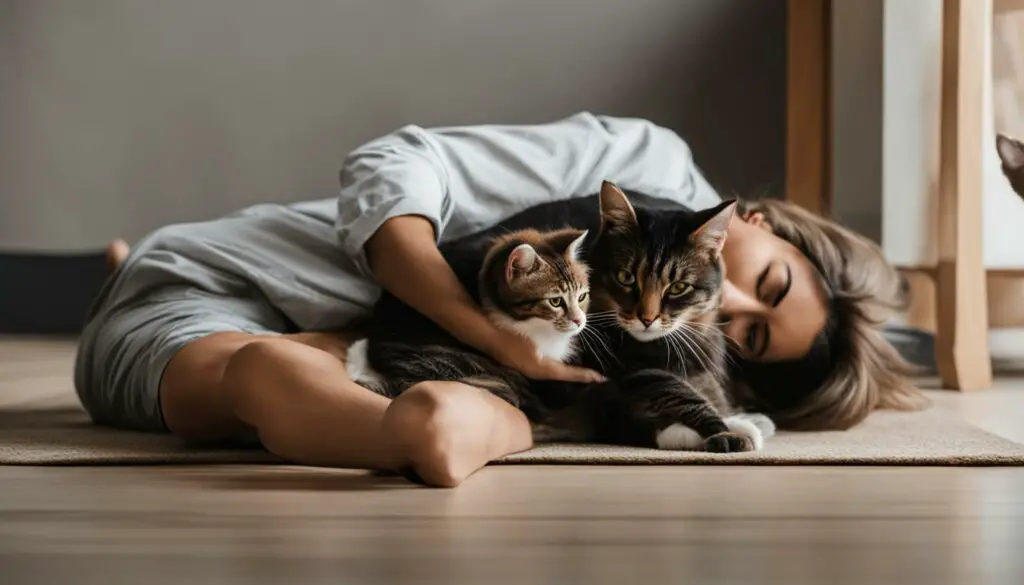
| Common Cat Body Language Signals | Meaning |
|---|---|
| Tail straight up, relaxed | Content and friendly |
| Puffed-up tail | Fear or aggression |
| Ears forward | Engagement and curiosity |
| Ears flattened | Sign of fear or aggression |
| Purring | Content and relaxed |
| Growling or hissing | Feeling threatened or aggressive |
Understanding these body language signals can help you gauge your cat’s mood and respond accordingly, enriching your interactions and strengthening your bond.
Conclusion
Understanding cat behavior is a fascinating journey that unveils the complexities of the feline mind. Delving into the realms of feline psychology and exploring the factors that influence their behavior, emotions, and cognitive abilities allows us to forge a deeper connection with these enigmatic creatures.
Contrary to popular belief, cats are not simply aloof animals. They possess a unique blend of instinct, individuality, and social behaviors that shape their interactions with humans and other cats. By recognizing their communication cues, providing a nurturing environment, and respecting their boundaries, we can strengthen the bond we share with our feline companions.
Feline psychology offers valuable insights into the intricate dance of instinct and individuality that governs cat behavior. From their evolutionary traits as solitary hunters to their peculiar attraction to boxes, each aspect of feline behavior adds to the captivating nature of these creatures.
By understanding cats on a deeper level, we can enrich their lives and provide the care they need to thrive. So, let’s continue our journey of unraveling the mysteries of cat behavior and foster a greater appreciation for the unique and fascinating world of our feline friends.
FAQ
Are cats really aloof?
Contrary to popular belief, cats do display social behaviors and communicate through vocalizations, body language, and scent marking.
Why do cats exhibit aloof behavior?
Cats’ aloof behavior can be traced back to their evolutionary history as solitary hunters and their tendency towards independence.
How do cats communicate with each other?
Cats communicate through a variety of vocalizations, body language, and scent marking.
Why do cats still display hunting behavior even if they are well-fed?
Cats’ hunting behavior is rooted in their evolutionary history as predators, and these instincts remain ingrained in their DNA.
Are cats more active during certain times of the day?
Cats are crepuscular creatures, meaning they are most active during the dawn and dusk hours.
Why do cats spend so much time grooming themselves?
Grooming helps regulate their body temperature, promote blood flow, and remove dirt and parasites from their coats.
Why are cats so fascinated with boxes?
Cats are attracted to boxes because they provide a cozy and secure environment where they can observe their surroundings without feeling vulnerable.
Can cats form strong bonds with their human companions?
Yes, cats form strong bonds with their human companions through understanding and respecting their unique characteristics and preferences.
What factors influence cat behavior?
Cat behavior is influenced by genetics, early experiences, and environmental factors.
What is feline psychology?
Feline psychology is the study of behavior, emotions, and cognitive abilities in cats.
Do different cat breeds have different behavior traits?
Yes, different cat breeds exhibit variations in behavior, temperament, and cognitive abilities.
Is it true that cats are aloof and uninterested in human affection?
No, cats form strong bonds with their human companions and exhibit affection in their own unique ways.
How does genetics influence cat behavior?
Genetics plays a significant role in shaping cat behavior, but other factors such as individual personality and the environment also contribute.
How can I ensure my cat’s emotional well-being?
Providing environmental enrichment, proper socialization, and consistent routines contribute to a cat’s emotional stability and overall happiness.
How can I effectively interact with my cat?
Understanding your cat’s unique behaviors and communication signals, respecting their boundaries, and providing positive reinforcement are key to building a strong bond.
Why is it important to understand cat behavior?
Understanding cat behavior helps us provide optimal care, create enriching environments, and foster a deeper connection with our feline companions.








